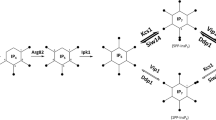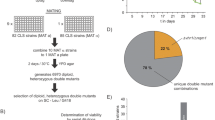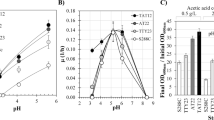Abstract
Although oxidative stress is involved in many human diseases, little is known of its molecular basis in eukaryotes. In a genetic approach, S. cerevisiae was used to identify elements involved in oxidative stress. By using hydrogen peroxide as an agent for oxidative stress, 34 mutants were identified. All mutants were recessive and fell into 16 complementation groups (pos1 to pos16 for peroxide sensitivity). They corresponded to single mutations as shown by a 2:2 segregation pattern. Enzymes reportedly involved in oxidative stress, such as glucose-6-phosphate dehydrogenase, glutathione reductase, superoxide dismutase, as well as glutathione concentrations, were investigated in wild-type and mutant-cells. One complementation group lacked glucose-6-phosphate dehydrogenase and was shown to be allelic to the glucose-6-phosphate dehydrogenase structural gene ZWF1/MET19. In other mutants all enzymes supposedly involved in oxidative-stress resistance were still present. However, several mutants showed strongly elevated levels of glutathione reductase, gluconate-6-phosphate dehydrogenase and glucose-6-phosphate dehydrogenase. One complementation group, pos9, was highly sensitive to oxidative stress and revealed the same growth phenotype as the previously described yap1/par1 mutant coding for the yeast homologue of mammalian transcriptional activator protein, c-Jun, of the proto-oncogenic AP-1 complex. However, unlike par1 mutants, which showed diminished activities of oxidative-stress enzymes and glutathion level, the pos9 mutants did not reveal any such changes. In contrast to other recombinants between pos mutations and par1, the sensitivity did not further increase in par1 pos9 recombinants, which may indicate that both mutations belong to the same regulating circuit. Interestingly, ten complementation groups were, in parallel, sensitive to osmotic stress, and one mutant allele revealed increased heat sensitivity. Our results indicate that a surprisingly large number of genes seem to be involved in oxidative-stress resistance and a possible overlap exists between osmotic stress and other stress reactions.
Similar content being viewed by others
References
Beauchamp C, Fridovich I (1971) Superoxide dismutase: improved assays an an assay applicable to acrylamide gels. Anal Biochem 44:276–287
Bergmeyer HU (1973) Methoden der enzymatischen Analyse. Verlag Chemie, Weinheim/Bergstraße/Germany
Bermingham-McDonogh O, Gralla EB, Valentine JS (1988) The copper, zinc-superoxide dismutase gene of Saccharomyces cerevisiae: cloning, sequencing and biological activity. Proc Natl Acad Sci USA 85:4789–4793
Bilinski T, Krawiec Z, Liczmanski A, Litwinska J (1985) Is hydroxyl radical generated by the Fenton chemistry? Biochem Biophys Res Commun 9:275–281
Brown JL, North S, Bussey H (1993) SKN7, a yeast multicopysuppressor of a mutation affecting cell wall β-glucan assembly, encodes for a product with domains homologous to prokaryotic two-component regulators and to heatshock transeription factors. J Bacteriol 175:6908–6915
Buettner GR (1993) The pecking order of free radicals and antioxidants: lipid peroxidation, α-tocopherol and ascorbate. Arch Biochem Biophys 300:535–543
Butler G, Thiele DJ (1991) ACE2, an activator of yeast metallothionein expression which is homologous to SW15. Mol Cell Biol 11:476–485
Chang EC, Kosman DJ (1989) Intracellular Mn(II)-associated superoxide scavenging activity protects Cu,Zn superoxide dismutase-deficient Saccharomyces cerevisiae against dioxygen stress. J Biol Chem 21:12172–12178
Cerutti PA (1985) Prooxidant states and tumor promotion. Science 227:375–381
Chowdbury S (1982) Salt tolerance in yeast. J Cell Biol 118:561–571
Ciriacy M (1975) Genetics of alcohol dehydrogenase in Saccharomyces cerevisiae. Isolation and genetic analysis of mutants. Mutat Res 29:315–326
Cohen G, Rapatz W, Ruis H (1988) Sequence of the yeast Saccharomyces cerevisiae CTA1 gene and amino-acid sequence of catalase A derived from it. Eur J Biochem 176:159–163
Coyle JT, Puttfarcken P (1993) Oxidative stress, glutamate and neurodegenerative disorders. Science 262:689–695
Devary Y, Gottlieb RA, Lau LF, Karin M (1991) Rapid and preferential activation of the c-jun gene during mammalian UV response. Mol Cell Biol 11:2804–2811
Ellman GL (1959) Tissue sulhydryl groups. Arch Biochem Biophys 82:70–77
Farr SB, Kogoma T (1991) Oxidative stress responses in Escherichia coli and Salmonella typhimurium. Microbiol Rev 55:561–585
Fowell E (1952) Sodium acetate as a sporulation medium for yeast. Nature 170:578–580
Fridovich L (1978) The biology of oxygen radicals. The superoxide radical is an agent of oxygen toxicity; superoxide dismutase provides an important defense. Science 201:875–880
Gralla EB, Thiele DJ, Silar P, Valentine JS (1991) ACE1, a copper-dependent transcription factor, activates expression of the yeast copper, zinc superoxide dismutase. Proc Natl Acad Sci USA 88:8558–8562
Gutteridge JMC, Halliwell B (1990) The measurement and mechanism of lipid peroxidation in biological systems. Trends Biochem Sci 15:129–135
Haber F, Weiss J (1934) Proc Roy Soc Lond (Ser A) 147:332–351
Harmon D (1956) Involvement of radicals in the ageing process J Gerontol 11:298–302
Harshman KD, Moye-Rowley WS, Parker CS (1988) Transcriptional activation by the SV40 AP-1 recognition element in yeast is mediated by a factor similar to AP-1 that is distinct from GCN4. Cell 531:321–330
Hartig A, Ruis H (1986) Nucleotide sequence of Saccharomyces cerevisiae CTT1-gene and deduced aminoacid sequence of catalase T. Eur J Biochem 160:487–490
Hussain M, Lenard J (1991) Characterization of PDR4, a Saccharomyces cerevisiae gene that confers pleiotropic drug resistance in high-copy number. Gene 101:149–152
Hertle K, Haase E, Brendel M (1991) The SNQ3 gene of Saccharomyces cerevisiae confers hyper-resistance to several functionally unrelated chemicals. Curr Genet 19:429–433
Hörtner H, Ammerer G, Hartter E, Hamilton B, Rytka J, Bilinski T, Ruis H (1982) Regulation of synthesis of catalases and iso-1-cytochrome c in Saccharomyces cerevisiae by glucose, oxygen and heme. Eur J Biochem 128:179–184
Hussain M, Lenard J (1991) Characterization of PDR4, a Saccharomyces cerevisiae gene that confers pleiotropic drug resistance in high-copy number. Gene 101:149–152
Imalay JA, Linn S (1988) DNA damage and oxygen radical toxicity. Science 240:1302–1309
Kaput J, Goltz S, Blobel G (1982) Nucleotide sequence of the yeast nuclear gene for cytochrome c peroxidase precursor: functional implications of the presequence of protein transport into mitochondria. J Biol Chem 257:15054–15058
Karin M, Najarian R, Haslinger A, Valenzuela P, Well J, Fogel S (1984) Primary structure and transcription of an amplified genetic locus; the CUP1 locus of yeast. Proc Natl Acad Sci USA 81:337–341
Mager WH, Varela JCS (1993) Osmostress response of the yeast Saccharomyces cerevisiae. Mol Microbiol 10:253–258
Marres CAM, Van Loon APGM, Oudshoorn P, van Steeg H, Grivell LA, Slater EC (1985) Nucleotide sequence analysis of the nuclear gene coding for manganese superoxide dismutase of yeast mitochondria, a gene previously assumed to code for the Rieske iron-sulphur protein. Eur J Biochem 147:153–161
Minc-Golomb D, Knobler H, Groner Y (1991) Gene dosage of CuZn-SOD and Down's syndrome diminished prostaglandin synthesis in human trisomy 21, transfected cells and transgenic mice. EMBO J 10:2119–2124
Moody CS, Hassan HM (1982) Mutagenicity of oxygen free radicals. Proc Natl Acad Sci USA 79:2855–2859
Moye-Rowley WS, Harshman KD, Parker CS (1989) Yeast YAP1 encodes a novel form of the jun family of transcriptional activator proteins. Genes Dev 3:283–292
Nogae I, Johnston M (1990) Isolation and characterization of the ZWF1 gene of Saccharomyces cerevisiae, encoding glucose-6-phosphate dehydrogenase. Gene 96:161–169
Ohtake Y, Yabuuchi S (1991) Molecular cloning of the gamma-glutamylcysteine synthetase gene of Saccharomyces cerevisiae. Yeast 7:953–961
Oyanagui Y (1984) Re-evaluation of assay methods and establishment of a kit for superoxide dismutase activity. Anal Biochem 142:290–296
Rosen DR, Siddique T et al. (1993) Mutations in the Cu/Zn superoxide dismutase gene are associated with familial amyotrophic lateral sclerosis. Nature 361:59–62
Schnell N, Entian KD (1991) Identification and characterization of a Saccharomyces cerevisiae gene (PAR1) conferring resistance to iron chelators. Eur J Biochem 200:487–493
Schnell N, Krems B, Entian KD (1992) The PAR1 (YAP1/SNQ3) gene of Saccharomyces cerevisiae, a c-jun homologue, is involved in oxygen metabolism. Curr Genet 21:269–273
Schreck R, Rieber P, Baeuerle PA (1991) Reactive oxygen intermediates are apparently widely used messengers in the activation of the NF-kB transcription factor and HIV-1. EMBO J 10: 2247–2258
Singh KK, Norton RS (1991) Metabolic changes inducing during adaptation of Sacharomyces cerevisiae to a water stress. Arch Microbiol 156:48–42
Stadtman ER (1992) Protein oxidation and ageing. Science 257: 1220–1224
Stillman DJ, Bankier AT, Seddon A, Groenhout EG, Nasmyth KA (1988) Characterization of a transcription factor involved in mothercell specific transcription of the yeast HO gene. EMBO J 7:485–494
Storz G, Tartaglia LA, Farr SB, Ames BN (1990) Bacterial defenses against oxidative stress. Trends Genet 6:363–368
Szczypka MS, Thiele DJ (1989) A cysteine-rich nuclear protein activates yeast metallothionein gene transcription. Mol Cell Biol 9:421–429
Thomas D, Cherest H, Surdin-Kerjan Y (1991) Identification of the structural gene for glucose-6-phosphate dehydrogenase in yeast. Inactivation leads to a nutritional requirement for organic sulfur. EMBO J 10:547–553
Vantfleteren JR (1993) Oxidative stress and ageing in Caenorhabditis elegans. Biochem J 292:605–608
Varela JCS, van Beekvelt C, Planta RJ, Mager WH (1992) Osmostress-induced changes in yeast gene expression. Mol Microbiol 6:2183–2190
Westerbeek-Marres CAM, Moore MM, Autor AP (1988) Regulation of manganese superoxide dismutase in Saccharomyces cerevisiae: the role of the respiratory chain. Eur J Biochem 174: 611–620
Zhou P, Szczypka MS, Sosinowski T, Thiele DJ (1992) Acel protein is a sensor for intracellular copper concentration and activates expression of metallothionein gene expression. Mol Cell Biol 12:3766–3775
Zamenhoff S (1957) Preparation and assay of deoxyribonucleic acids from animal tissue. Methods Enzymol 3:696–704
Author information
Authors and Affiliations
Additional information
Communicated by F. K. Zimmermann
Rights and permissions
About this article
Cite this article
Krems, B., Charizanis, C. & Entian, K.D. Mutants of Saccharomyces cerevisiae sensitive to oxidative and osmotic stress. Curr Genet 27, 427–434 (1995). https://doi.org/10.1007/BF00311211
Received:
Issue Date:
DOI: https://doi.org/10.1007/BF00311211




